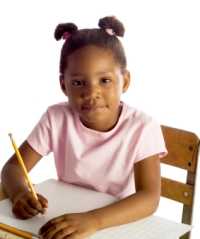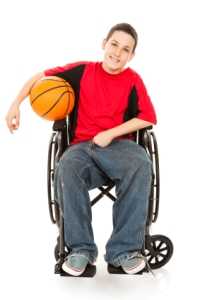Living With Spina Bifida: School-Aged Children

Starting school brings children into regular contact with the larger world. Friendships become important and physical, social, and mental skills develop rapidly during this time. Children who feel good about themselves are more able to resist negative peer pressure and make better choices.
This is an important time for children to become more responsible and independent. This is also a good time to start exploring potential lifetime interests such as hobbies, music, or sports. Developing independence can be challenging for people affected by spina bifida. It is important to begin working on this process early in childhood.
School
Many children with spina bifida do well in school. But some can experience difficulties, especially children with shunts that are used to treat hydrocephalus (often called water on the brain). These children often have problems with learning. They might have difficulty paying attention or work slowly, be restless, or lose things. They also might have trouble making decisions. There are activities that children can do at home and at school to help with these problems. Healthcare professionals can provide information about these activities.
Individualized Education Plan (IEP)
An Individualized Education Plan is important because it will help children develop skills at school. Children who participate in special education classes will have an IEP. An IEP is a legal document that lets the school know what kinds of assistance will be needed by a child during the school day. An IEP is created by parents and school personnel, such as a psychologist, teachers, a school nurse, and a physical education teacher, as well as any other professionals that parents think might be helpful.
504 Plan
If a child does not qualify for an IEP, parents can request a 504 Plan be developed for their child at school. Usually, a 504 Plan is used by a general education student who is not eligible for special education services. By law, children may be eligible to have a 504 Plan which lists accommodations related to a child’s disability. The 504 Plan accommodations may be needed to give the child an opportunity to perform at the same level as their peers. For example, a 504 Plan may include the child’s assistive technology needs, such as using a tablet or laptop computer to take notes, and making sure they have a wheelchair accessible environment at school.
For more information, please visit the Spina Bifida Association website:
Educational Issues Among Children with Spina Bifida
Learning Among Children with Spina Bifida
Learning and Education Information for Parents, including IEP and 504 Plans
Reading Comprehension Difficulties and Spina Bifida
Math Difficulties and Spina Bifida
Physical Health―What to Expect
No two children with spina bifida are exactly alike. Health issues will be different for each child. Some children have issues that are more severe than other children. With the right care, children born with spina bifida will grow up to reach their full potential.

Mobility and Physical Activity
Children with spina bifida higher on the spine (near the head) might have paralyzed legs and use wheelchairs. Those with spina bifida lower on the spine (near the hips) might have more use of their legs and use crutches, braces, or walkers, or they might be able to walk without these devices.
A physical therapist can work with children, parents, and caregivers to teach them how to exercise the child’s legs to increase strength, flexibility, and movement.
Regular physical activity is important for all children, but especially for those with conditions that affect movement, such as spina bifida. CDC recommends 60 minutes of physical activity a day. There are many ways for children with spina bifida to be active. For example, they can:
- Engage in active play with friends.
- Roll or walk in the neighborhood.
- Enjoy parks and recreation areas with playgrounds that are accessible for those with disabilities.
- Attend summer camps and recreational facilities that are accessible for those with disabilities.
- Participate in sports activities (for example, swimming) and teams for people with or those without disabilities.
For more information, please visit the following websites:
National Center on Physical Activity and Disability (NCPAD) – Spina Bifida Guidelines
Using the Bathroom
Children with spina bifida often cannot control when they go to the bathroom (incontinence). They also can develop urinary tract infections. It is important to develop a plan for going to the bathroom that works and is as simple as possible. This can lead to increased health, participation, and independence at school and in the home, and avoid embarrassment for children with spina bifida. Healthcare providers can help develop a plan. A tube (catheter) inserted in the child’s bladder can help drain urine. In some cases, extra fiber can be added to the diet to keep bowel movements regular. Surgery also might be recommended.
For more information, please visit the Spina Bifida Association website:
Skin
Children with spina bifida can develop sores, calluses, blisters, and burns on their feet, ankles, and hips. However, they might not know when these develop because they might not be able to feel certain parts of their body.
Parents and caregivers can help protect the child’s skin and teach the child how to do this, too, by:
- Checking the child’s skin every day for redness, including under braces.
- Trying to avoid hot bath water, hot irons and hot or unpadded seatbelt clasps that may cause burns.
- Making sure the child wears properly fitting shoes at all times.
- Using sunscreen on the child and making sure the child doesn’t stay out in the sun too long.
- Making sure the child does not sit or lie in one position for too long.
Did You Look? Healthy Skin Starts With You! Care for school-aged children with spina bifida
Latex (Natural Rubber) Allergy
Many children with spina bifida are allergic to products that contain latex, or natural rubber. This means they should not use items made of natural rubber. A child with this type of allergy can wear a bracelet to alert other people of the allergy.
For more information, please visit the Spina Bifida Association website:
Latex (Natural Rubber) Allergy in Spina Bifida
Health Checks
Every child needs a primary care provider (for example, a pediatrician, family doctor, or nurse practitioner). The primary health care provider will want to make sure that the child is healthy; developing normally; and receiving immunizations against diseases and infections, including the flu.
In addition to seeing a primary health care provider, a child with spina bifida will be checked and treated as needed by doctors who specialize in different parts of the body. These doctors might suggest treatments or surgeries to help the child.
These specialists might include:
- An orthopedist, who will work with the child’s muscles and bones.
- A urologist, who will check the child’s kidneys and bladder.
- A neurosurgeon, who will check the child’s brain and spine.
Safety
Safety is an important issue for children with spina bifida. They can be at higher risk for injuries and abuse. As these children become more independent, it is important for their parents and other family members to teach them how to stay safe and what to do if they feel threatened or have been hurt in any way.
For more information, please visit the following websites:
Children – Safety in the Home & Community
Bullying Among Children and Youth with Special Needs and Disabilities
Finding Support
Having support and community resources can help increase confidence in managing spina bifida, enhance quality of life, and assist in meeting the needs of all family members. It might be helpful for parents of children with spina bifida to talk with one another. One parent might have learned how to address some of the same concerns another parent has. Often, other parents of children with special needs can give advice about good resources for these children.
Remember that the choices of one family might not be best for another family, so it’s important that parents understand all options and discuss them with their child’s health care providers.
- A Spina Bifida Association (SBA) Chapter is a great place to connect with other families. The SBA website can provide information on how to find a local chapter.
- The Spina Bifida Association Parents ListServ bring people together online to discuss topics such as parenting a child with spina bifida and growing up with spina bifida.
- National Resource Center Get information and find clinics or health care providers who are experts on spina bifida.
References
Sandler, Adrian, M.D.(2004). Living with Spina Bifida: A Guide for Families and Professionals. University of North Carolina Press: Chapel Hill.
Merkens, Mark J., M.D. and the Spina Bifida Association’s Professional Advisory Council (2006). Guidelines for Spina Bifida Health Care Services Throughout the Lifespan. Third Edition. Spina Bifida Association.
Primary Children’s Medical Center (2008). Let’s Talk about Spina Bifida.
- Page last reviewed: September 18, 2017
- Page last updated: September 18, 2017
- Content source:


 ShareCompartir
ShareCompartir